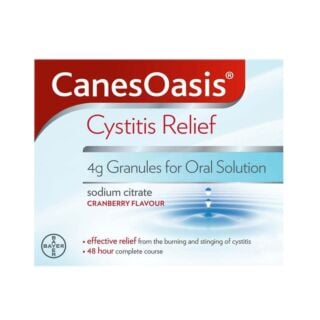How to tell the difference between UTIs and STIs

Have you ever wondered what the difference is between STIs and UTIs?
ANSWER: The main difference is that UTIs are not sexually transmitted. Having sex can result in a UTI, but this doesn’t mean the infection is spread from person to person through sexual contact. STIs, on the other hand, are spread through unprotected sexual contact with an infected person.
While both can cause similarly unpleasant symptoms down below, UTIs and STIs are entirely different issues with equally different causes and treatment options.
UTI stands for urinary tract infection, while STI stands for sexually transmitted infection. In this guide, we’ll explore the symptoms of UTIs and STIs in both men and women, the difference between the two, and what you can do to treat and prevent these nasty infections!
What is a urinary tract infection (UTI)?
A urinary tract infection (UTI) can affect any part of your urinary tract - that includes your bladder, urethra and kidneys.
Most commonly, UTIs will affect the lower urinary tract (the bladder and urethra). Whilst these types of infections usually aren’t serious, occasionally bacteria can travel up from the bladder into one or both of the kidneys. If a kidney infection isn’t treated quickly, it can cause permanent damage.
That’s why it’s beneficial to be able to identify the symptoms of a UTI and, if necessary, start treatment before the infection has any chance of spreading.
Symptoms of UTIs
Symptoms of UTIs can range from mildly uncomfortable to very painful, potentially affecting your ability to undertake your daily activities as normal. While women are much more likely to be affected than men, the symptoms of UTIs in men and women are the same. These symptoms can include:
- Pain or a burning sensation when peeing (dysuria)
- Needing to pee more often than usual during the night (nocturia)
- Pee that looks cloudy
- Needing to pee suddenly or more urgently than usual
- Blood in your pee
- Lower tummy pain or pain in your back, just under the ribs
- A high temperature, or feeling hot and shivery
- A very low temperature below 36°C
It’s also important to note that UTI symptoms can differ slightly in children. Children with UTIs may have a high temperature, appear generally unwell (babies may be irritable and not feed properly), wet the bed or wet themselves, or be sick.
Elderly or frail people with a UTI may display changes in behaviour like acting confused or agitated, as well as symptoms such as worsened incontinence and shivering or shaking.
Types of UTIs
There are a few different types of UTI, named depending on which particular area of the urinary tract is infected. While symptoms of these different types of UTI can be similar, there are some differences.
Cystitis (Bladder): A bladder infection is one of the most common types of UTI. The main symptoms of cystitis include pain or stinging when you pee, needing to pee more often or urgently than usual, pee that’s dark, cloudy or strong smelling, and pain low down in your tummy.
Urethritis (Urethra): An infection or inflammation of the urethra, the hollow tube that drains urine from the bladder to the outside of the body. Symptoms of urethritis will be similar to cystitis, but you may also notice discharge.
Pyelonephritis (Kidney): Generally caused by cystitis that has spread up the bladder into the kidneys, pyelonephritis is characterised by cystitis symptoms as well as pain in your back or side, fever and feeling shivery or sick.
Causes of UTIs
UTIs typically occur when bacteria from the gut (usually E. coli) enters the urinary tract through the urethra. This is far more likely in women than men simply due to differences in anatomy.
Women commonly develop UTIs after sex, when the urethra comes into contact with bacteria from the genitals and anus. Wiping your bottom ‘back to front’ can also lead to a UTI, as this allows bacteria from the bowel and vagina to enter the urethral opening to the bladder.
Other causes of UTIs include:
- Pregnancy
- Conditions that block the urinary tract, such as kidney stones
- Conditions that make it difficult to fully empty the bladder, such as an enlarged prostate in men or constipation in children
- Urinary catheters
- Having a weakened immune system
- Not drinking enough fluids
- Not keeping the genital area clean and dry
UTI Diagnosis
If you think you have a UTI, your best course of action is to visit your GP. This is especially important if it’s the first time you’ve ever suspected having a UTI, or if you’re pregnant, male, or have recently had surgery. It’s also important to visit a GP if someone you’re caring for, such as a child or elderly person, has symptoms of a UTI.
Your GP will ask you about your symptoms and most likely request a urine sample. If your urine sample shows signs of bacteria or white blood cells, it’s likely that you are suffering from a UTI and treatment may be needed.
UTI Treatments
UTIs don’t always need treatment. If your symptoms haven’t been present for long, your GP may suggest waiting 48 hours in case you start to feel better on your own. This is to avoid the unnecessary use of antibiotics that could contribute to antibiotic resistance. In the meantime, cystitis relief sachets or a painkiller like paracetamol may help to manage your symptoms.
If your symptoms haven’t gone away on their own within 48 hours, a short course of antibiotics may be needed. Don’t forget: it’s important to complete the full course, even if you start to feel better before it’s finished.
If your UTI comes back within 6 months, or you keep getting recurrent UTIs, your GP may prescribe a short course of a different antibiotic or a low-dose antibiotic to take for up to 6 months.

What is a sexually transmitted infection (STI) or STD?
Sexually transmitted infections (STIs) or sexually transmitted diseases (STDs) are infections passed on through sexual contact. That includes unprotected vaginal, anal or oral sex as well as genital touching. Some STIs can also be passed on from a pregnant or breastfeeding mother to her baby.
Most STIs are easily treatable, but it’s important to avoid having any sexual contact until the problem has been treated appropriately and the infection is no longer contagious.
Types of STIs
There are many types of STI and STD, and they’re more common than you’d realise. According to the World Health Organisation (WHO), more than 1 million STIs are acquired every day worldwide. The most common types of STI include:
- Chlamydia
- Gonorrhoea
- Trichomoniasis
- Genital warts
- Genital herpes
- Pubic lice
- Scabies
- Syphilis
- Human papillomavirus (HPV)
The symptoms of these infections will vary but may include unusual discharge, lumps, skin growths, pain when peeing, a rash, unusual vaginal bleeding, itchy genitals or anus, warts and blisters.
It should be pointed out that STIs often don’t present any symptoms at all and they can go completely unnoticed, which is why it’s so important to get tested before engaging in any sexual contact with a new partner.
Causes of STIs
STIs can affect anyone who has taken part in unprotected vaginal, oral or anal sex. They’re either caused by bacteria (i.e. chlamydia, gonorrhoea), parasites (trichomoniasis) or viruses (herpes, HPV).
Factors that may increase your risk of developing an STI can include:
- Having unprotected sex (sex without a condom)
- Having sexual contact with multiple partners
- Having a history of STIs
- Injecting drugs and sharing needles
You can prevent or reduce your risk of getting an STI by having protected sex with a condom, staying with one partner or making sure new partners have been tested, and getting vaccinated against certain STIs like HPV.
STI Diagnosis
If you think you might have an STI, your best option is to visit a sexual health clinic as soon as possible, making sure to avoid sexual contact during this time. Sexual health clinics are often able to diagnose and treat STIs quicker than GP surgeries, and you don’t even need to give your real name if you don’t want to.
At the sexual health clinic, you’ll be asked questions about your sexual activity and a doctor or nurse may ask to look at your genitals or anus so swabs can be taken to test for STIs.
If these tests do show you’ve got an STI, you’ll need to start the appropriate treatment as soon as possible and let any ex-partners know so they can get tested too. If you don’t feel comfortable doing this, the clinic will usually be able to contact them without naming you.
STI Treatments
STIs can be unpleasant, but don’t panic! Many STIs are completely curable or can be managed easily with treatment. If you’re diagnosed with a common bacterial STI like chlamydia or gonorrhoea, a course of antibiotics will typically clear up the infection within a couple of weeks.
If you’ve been diagnosed with a viral STI like genital herpes, you may be prescribed an antiviral medicine to stop the symptoms from getting worse.
Your treatment plan will depend on which type of STI you have, but the quicker you start treatment the better. STIs can cause serious complications if left untreated, sometimes resulting in pelvic inflammatory disease (PID), infertility, birth defects or even severe damage to your vital organs.
Difference between STIs & UTIs
The main difference is that UTIs are not sexually transmitted. Having sex can result in a UTI due to the urethra coming into physical contact with bacteria from the genitals and anus, but this doesn’t mean the infection is spread from person to person through sexual contact. There are also plenty of other ways to get a UTI, such as wiping your bottom ‘back to front’ or being pregnant. STIs, on the other hand, are spread through unprotected sexual contact with an infected person.
If you’ve got a UTI, your symptoms will be bladder-related. That means you might experience a burning sensation while peeing, peeing more often than usual or cloudy urine. If you’ve got an STI, a range of varied symptoms may affect your genital area rather than your bladder. You may notice abnormal discharge, blisters, lumps or rashes, itchiness or even pain during intercourse.
Similarity in Symptoms
While there are some clear differences between the symptoms of UTIs and STIs, occasionally it can be difficult to spot the difference.
For example, whilst blood in your pee is more likely to be a UTI, it could also be a sign of chlamydia or gonorrhoea. Some STIs can also display other symptoms that are very similar to UTIs, like pain or burning while peeing, cloudy urine or needing to pee more often than usual.
If you’re not sure whether you’ve got a UTI or an STI, the best thing you can do is visit your GP so they can perform the necessary tests to determine what the problem is and what type of treatment you need.
Prevention of UTIs & STIs
With their equally unpleasant symptoms, UTIs and STIs aren’t fun, and we’d all rather avoid them if possible. Luckily, there are plenty of ways to reduce your risk of getting both types of infection.
UTI prevention
You can’t always prevent a UTI, but there are things you can do to reduce your risk. Follow these tips:
- Wipe from front to back after using the toilet
- Keep the genital area clean and dry
- Drink lots of water
- Wash the skin around the vagina with water before and after sex
- Pee as soon as possible after sex
- Avoid scented soap
- Don’t hold your pee if you feel the urge to go
- Always empty your bladder fully
- Avoid wearing tight or synthetic underwear
Some evidence also suggests that taking a cystitis sachet every day, or drinking cranberry juice regularly, can prevent UTIs or relieve their symptoms. However, these are not a substitute for antibiotics and won’t get rid of an existing UTI.
STI/STD prevention
Preventing an STI or STD all comes down to practising safe sex, and there are a number of things you can do to reduce your risk:
- Use a condom during sex (including oral and anal sex)
- Make sure you and your partner have been tested
- Avoid sex after drinking too much alcohol or taking drugs, as these affect your ability to make good decisions
- Have the vaccine against HPV if you’re eligible
- If you’re at high risk of HIV, consider pre exposure prophylaxis (PrEP)

Whilst UTIs and STIs are completely different, they can be equally uncomfortable! If you’re suffering with any symptoms related to either type of infection, don’t hesitate to visit your GP or sexual health clinic. These are extremely common problems and there’s no reason to be embarrassed!
In the meantime, we’ve got a huge range of treatments to help you prevent or soothe the symptoms of a UTI, along with plenty of condoms to avoid those dreaded STIs!








